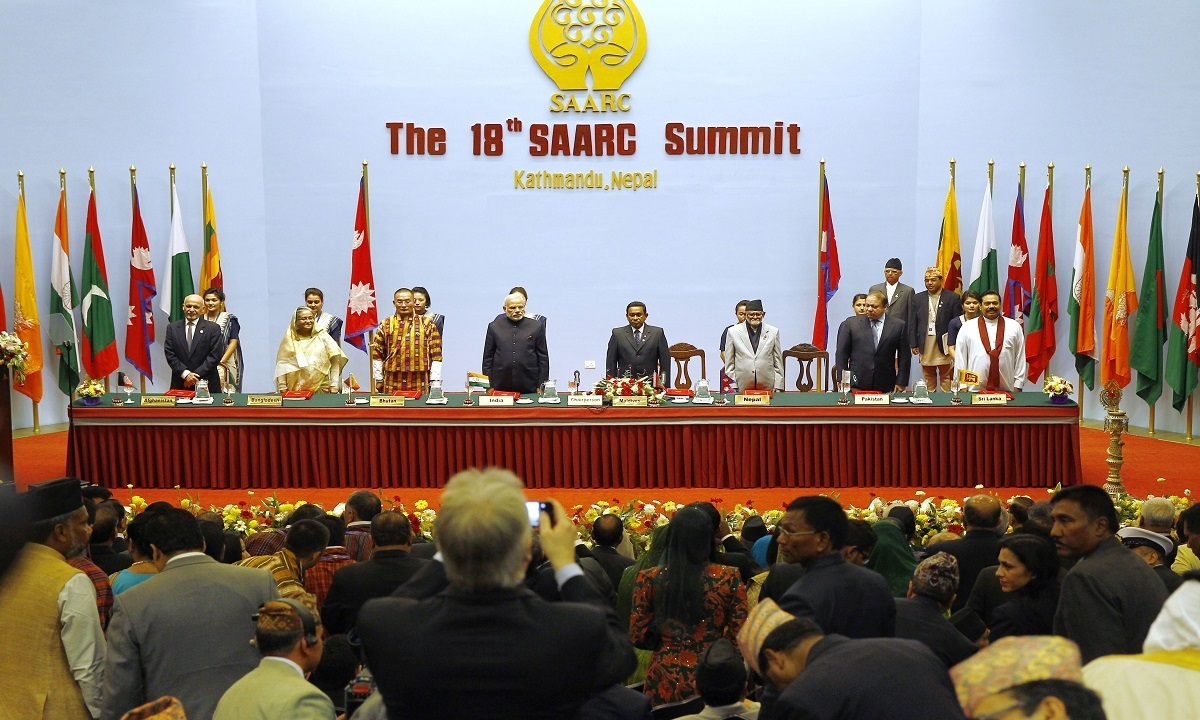With the symbolic gesture, Prime Minister Narendra Modi invitation for the head of states of South Asian nations at the swearing-in ceremony and his commitment to the shared prosperity of the region had imparted the new rays of hope to the resuscitation of the SAARC. But, the unfolding developments didn’t uphold the same. The decision of the leaders may significantly differ considering the rationality of foreign relations in changed context is valid, but the sluggishness of SAARC continued to remain the fact.
Least Integrated Region
During 18th SAARC Summit in Kathmandu, Modi candidly accepted the failure of SAARC, “when we speak of SAARC, we usually hear two reactions – cynicism and skepticism… as SAARC we have failed to move with the speed that our people expect and want.” South Asia, the fastest growing economy, is also the least integrated regions in the world. The World Bank reported intra-regional trade at less than 5% of total trade compared to East Asia’s 35% and Europe’s 60%. And in many cases, regional travel costs exceed the costs of countries traveling beyond the regions. Whereas, ‘infrastructure window’ of SAARC Development Fund (SAF) have almost remained dormant, which if materialized can contribute in these areas.
Ensuring seamless movement of goods and people has the utmost importance. Addressing via video to the conference on `Re-Energizing the SAARC Process’ in Singapore this August, Amjad Hussain B. Sial, Secretary-General of SAARC stated ‘connectivity is a sine quo non for regional integration’. In contrast, Pakistan had stalled from inking the SAARC motor vehicles agreements (MVA) 18th SAARC Summit in Kathmandu, stating it has not completed its internal process. The BBIN member countries −Bangladesh, Bhutan, Nepal and India− have tried to take it forward from sub-regional fora but after Bhutan’s rejection from signing the BBIN MVA in the pretext that influx of vehicles from the BBIN countries will impact the domestic transporters and degradation of the environment, this process also has been stalled. While accusing India’s unwillingness to develop a collaborative project, Pakistan furthermore abandoned the SAARC satellite project. Later, it was named as ‘South Asian Satellite’ intended to contribute in communications and disaster management of member countries− as a gift funded entirely by India.
India-Pakistan Hostility
The perennial conflict between India and Pakistan, primarily, considered as the fundamental impediments for the functioning of the SAARC in its full potentials. In this context, especially Indian scholars also argue for “SAARC-minus-one” policy − circumventing Pakistan. The predominant position of India in the region also demands the greater role to be played in the SAARC.
Geopolitics of South Asia
The enormous power shifting to Asia and the notion of balance of power has the fundamental reason for the push and pull of great power politics in South Asia. Historically, geographically, culturally and also economically, India certainly is the major regional actor and has the greater advantage in South Asia. Notwithstanding, India’s consideration of its pre-eminent role in South Asia is in limbo and is likely to remain so, at least taking into account the core facets of the balance of power theory in one hand while on the other hand India’s very minimal concrete deliverable to the region. India’s ‘neighborhood first’ policy in many ways remains a center for criticism from both inside-outside, for instance, failure of policy in Nepal.
Most of the countries excluding India are positive about the inclusion of China in SAARC and beliefs will provide the fresh impetus to the revitalization of SAARC. China is already taking the strong foothold by fulfilling the regional connectivity vacuum of the South Asian regions. Proclaiming region as its sphere of influence and abandoning the idea of inclusion of China into SAARC, India must shift its wherewithal on economic development and prosperity of the region. If it will be no longer the case, every other member of SAARC certainly will continue to resist interference and grab the opportunities in every way possible- the uncertainty of India’s pre-eminent role in the region will prevail much strongly.
Beyond Buck-Passing
The continuation of ‘buck-passing’ doesn’t help in any way in order to solve the ‘common good problems’ of South Asian region. As far as regional integration is a concern, it seems India has enormously shifted its priority, particularly, from SAARC. There is no any wonder that if the regional forum is not moving smoothly than focus should be on the sub-regional forum. Ultimately, successes of the sub-regional forum can be the catalyst for the revival of the regional forum. But it will be proactive to think an organization like BBIN and BIMSTEC as a complimentary to SAARC rather than exclusionary.
As reported, currently, India has massive ($15 billion) trade surplus with other SAARC countries, with exports worth $17.5 billion and imports of just $2.5 billion. The World Bank study concluded that ‘an unrestricted electricity trade provision could save $9 billion a year in electricity supply costs in South Asia’. Briefings on SAARC by Brookings suggested if Indo-Pakistan relations ameliorate ‘SAARC can emerge as one of the largest trading blocs in manufacturing and services’.
Conflict and cooperation are the fundamental dynamics of the international relations. Minimization of trust deficit is the prerequisite for the optimization of cooperation. In this context, the regional forum provides the opportunities for member states to enhance the cooperation. Indo-Chinese military stand-off had ended at Doklam plateau before the BRICS summit, at least giving both sides chance to rethink their respective policy approach. The handshake between erstwhile President Pervez Musharraf and Indian Prime Minister Atal Behari Vajpayee in Kathmandu during SAARC summit in 2002 was contemplated as the ice-breaker to Indo-Pak relations. But indeed, handshake alone doesn’t work in order to accomplish the journey of peace, tranquility, progress, and prosperity of South Asia. Mitigating the conflict and ameliorating the genuine cooperation is pivotal.
DISCLAIMER: The views and opinions expressed in this article are those of the author and do not necessarily reflect the official policy and position of Regional Rapport.



